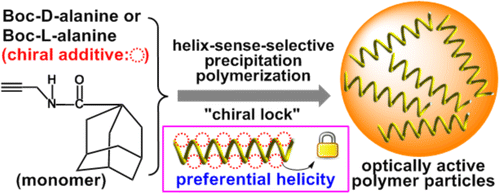
Optically active polymer particles constitute a unique type of polymer particle. However, nearly all the particles of this kind so far reported in the literature were prepared from chiral monomers. On the other hand, helix-sense-selective polymerization (HSSP) techniques were majorly applied in solution polymerization systems for preparing helical polymers adopting predominant onehanded helicity. In the present study, we report the first HSSP in precipitation polymerization systems, by which optically active helical polymer particles were constructed from an achiral monomer. Achiral acetylenic monomer with bulky adamantyl group **oothly underwent helix-sense-selective precipitation polymerization (HSSPP) with (nbd)Rh+ B−(C6H5)4 as catalyst in the presence of Boc-L- or Boc-D-alanine as chiral additive. The HSSPPs provided optically active polymer particles consisting of helical polymer forming predominantly one-handed screw sense. SEM images show that the resulting polymer particles were obtained in high yield (80 wt %, average diameter approximately 300 nm) with regular spherical morphology. CD spectra clearly demonstrated that HSSP occurred in the course of precipitation polymerizations. The induced helical structures with preferential screw sense exhibited relatively high thermostability. We further proposed a possible mechani** for the occurrence of HSSPPs and the formation of stable helical structures: Double hydrogen bonds formed between each chiral additive molecule and the neighboring two amide structures in the polymer pendant groups; the double hydrogen bonds played essential roles for controlling the screw sense of the helical polymer chains and the stability. Based on this mechani**, a “chiral-lock effect” was further put forward. The preparative strategy opens new routes for preparing optically active polymer particles and even novel superhelical architectures for significant uses as chiral stationary phase for HPLC, chiral catalysts, enantioselective recognition probes, etc.
